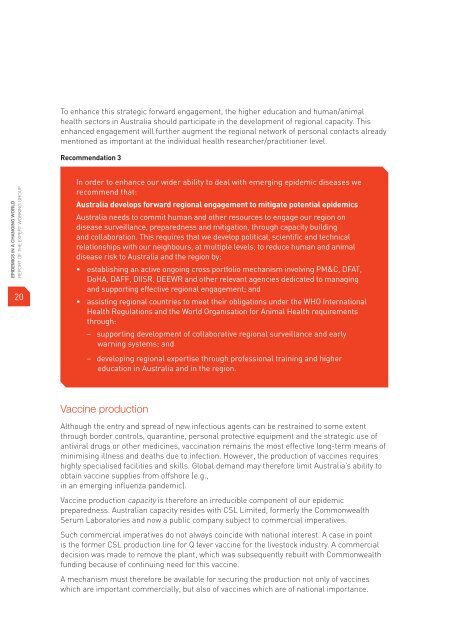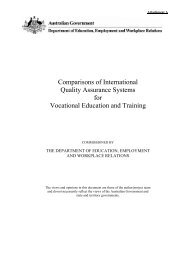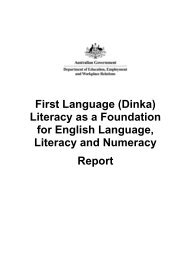Epidemics in a Changing World - Department of Innovation, Industry ...
Epidemics in a Changing World - Department of Innovation, Industry ...
Epidemics in a Changing World - Department of Innovation, Industry ...
You also want an ePaper? Increase the reach of your titles
YUMPU automatically turns print PDFs into web optimized ePapers that Google loves.
To enhance this strategic forward engagement, the higher education and human/animal<br />
health sectors <strong>in</strong> Australia should participate <strong>in</strong> the development <strong>of</strong> regional capacity. This<br />
enhanced engagement will further augment the regional network <strong>of</strong> personal contacts already<br />
mentioned as important at the <strong>in</strong>dividual health researcher/practitioner level.<br />
Recommendation 3<br />
EpidemICs <strong>in</strong> a Chang<strong>in</strong>g <strong>World</strong><br />
Report <strong>of</strong> the Expert Work<strong>in</strong>g Group<br />
20<br />
In order to enhance our wider ability to deal with emerg<strong>in</strong>g epidemic diseases we<br />
recommend that:<br />
Australia develops forward regional engagement to mitigate potential epidemics<br />
Australia needs to commit human and other resources to engage our region on<br />
disease surveillance, preparedness and mitigation, through capacity build<strong>in</strong>g<br />
and collaboration. This requires that we develop political, scientific and technical<br />
relationships with our neighbours, at multiple levels, to reduce human and animal<br />
disease risk to Australia and the region by:<br />
• establish<strong>in</strong>g an active ongo<strong>in</strong>g cross portfolio mechanism <strong>in</strong>volv<strong>in</strong>g PM&C, DFAT,<br />
DoHA, DAFF, DIISR, DEEWR and other relevant agencies dedicated to manag<strong>in</strong>g<br />
and support<strong>in</strong>g effective regional engagement; and<br />
• assist<strong>in</strong>g regional countries to meet their obligations under the WHO International<br />
Health Regulations and the <strong>World</strong> Organisation for Animal Health requirements<br />
through:<br />
– support<strong>in</strong>g development <strong>of</strong> collaborative regional surveillance and early<br />
warn<strong>in</strong>g systems; and<br />
– develop<strong>in</strong>g regional expertise through pr<strong>of</strong>essional tra<strong>in</strong><strong>in</strong>g and higher<br />
education <strong>in</strong> Australia and <strong>in</strong> the region.<br />
Vacc<strong>in</strong>e production<br />
Although the entry and spread <strong>of</strong> new <strong>in</strong>fectious agents can be restra<strong>in</strong>ed to some extent<br />
through border controls, quarant<strong>in</strong>e, personal protective equipment and the strategic use <strong>of</strong><br />
antiviral drugs or other medic<strong>in</strong>es, vacc<strong>in</strong>ation rema<strong>in</strong>s the most effective long-term means <strong>of</strong><br />
m<strong>in</strong>imis<strong>in</strong>g illness and deaths due to <strong>in</strong>fection. However, the production <strong>of</strong> vacc<strong>in</strong>es requires<br />
highly specialised facilities and skills. Global demand may therefore limit Australia’s ability to<br />
obta<strong>in</strong> vacc<strong>in</strong>e supplies from <strong>of</strong>fshore (e.g.,<br />
<strong>in</strong> an emerg<strong>in</strong>g <strong>in</strong>fluenza pandemic).<br />
Vacc<strong>in</strong>e production capacity is therefore an irreducible component <strong>of</strong> our epidemic<br />
preparedness. Australian capacity resides with CSL Limited, formerly the Commonwealth<br />
Serum Laboratories and now a public company subject to commercial imperatives.<br />
Such commercial imperatives do not always co<strong>in</strong>cide with national <strong>in</strong>terest. A case <strong>in</strong> po<strong>in</strong>t<br />
is the former CSL production l<strong>in</strong>e for Q fever vacc<strong>in</strong>e for the livestock <strong>in</strong>dustry. A commercial<br />
decision was made to remove the plant, which was subsequently rebuilt with Commonwealth<br />
fund<strong>in</strong>g because <strong>of</strong> cont<strong>in</strong>u<strong>in</strong>g need for this vacc<strong>in</strong>e.<br />
A mechanism must therefore be available for secur<strong>in</strong>g the production not only <strong>of</strong> vacc<strong>in</strong>es<br />
which are important commercially, but also <strong>of</strong> vacc<strong>in</strong>es which are <strong>of</strong> national importance.
















